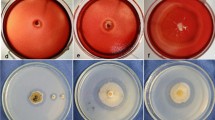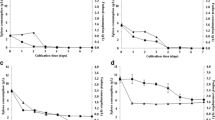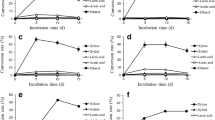Abstract
The ability of xylanolytic enzymes produced by Aspergillus fumigatus RP04 and Aspergillus niveus RP05 to promote the biobleaching of cellulose pulp was investigated. Both fungi grew for 4–5 days in liquid medium at 40°C, under static conditions. Xylanase production was tested using different carbon sources, including some types of xylans. A. fumigatus produced high levels of xylanase on agricultural residues (corncob or wheat bran), whereas A. niveus produced more xylanase on birchwood xylan. The optimum temperature of the xylanases from A. fumigatus and A. niveus was around 60–70°C. The enzymes were stable for 30 min at 60°C, maintaining 95–98% of the initial activity. After 1 h at this temperature, the xylanase from A. niveus still retained 85% of initial activity, while the xylanase from A. fumigatus was only 40% active. The pH optimum of the xylanases was acidic (4.5–5.5). The pH stability for the xylanase from A. fumigatus was higher at pH 6.0–8.0, while the enzyme from A. niveus was more stable at pH 4.5–6.5. Crude enzymatic extracts were used to clarify cellulose pulp and the best result was obtained with the A. niveus preparation, showing kappa efficiency around 39.6% as compared to only 11.7% for that of A. fumigatus.



Similar content being viewed by others
References
Valcheva E, Valchev I, Yotova L (2001) Kinetics of enzyme action Cartazyme NS-10 prior to bleaching of kraft pulp. Biochem Eng J 7:223–226. doi:10.1016/S1369-703X(00)00127-3
Polizeli MLTM, Rizzatti ACS, Monti R, Terenzi HF, Jorge JA, Amorim DS (2005) Xylanases from fungi: properties and industrial applications. Appl Microbiol Biotechnol 67:577–591. doi:10.1007/s00253-005-1904-7
Zhao J, Li X, Qu Y, Gao P (2002) Xylanase pretreatment leads to enhanced soda pulping of wheat straw. Enzyme Microb Technol 30:734–740. doi:10.1016/S0141-0229(02)00050-9
Techapun C, Poosaran N, Watanabe M, Sasaki K (2003) Thermostable and alkaline-tolerant microbial cellulase-free xylanases produced from agricultural wastes and properties required for use in pulp bleaching bioprocess: a review. Process Biochem 38:1327–1340. doi:10.1016/S0032-9592(02)00331-X
Beg QK, Kapoor M, Mahajan L, Hoondal GS (2001) Microbial xylanases and their industrial applications: a review. Appl Microbiol Biotechnol 56:326–338. doi:10.1007/s002530100704
Rizzatti ACS, Sandrim VC, Jorge JA, Terenzi HF, Polizeli MLTM (2004) Influence of temperature on the properties of xylanolytic enzymes of the thermotolerant fungus Aspergillus phoenicis. J Ind Microbiol Biotechnol 31:88–93. doi:10.1007/s10295-004-0120-2
Salles BC, Medeiros RG, Bao SN, Silva FG Jr, Filho EXF (2005) Effect of celulase-free xylanases from Acrophialophora nainiana and Humicola grisea var. thermoidea on eucalyptus kraft pulp. Process Biochem 40:343–349. doi:10.1016/j.procbio.2004.01.008
Sandrim VC, Rizzatti ACS, Terenzi HF, Jorge JA, Milagres AMF, Polizeli MLTM (2005) Purification and biochemical characterization of two xylanases produced by Aspergillus caespitosus and their potential for kraft pulp bleaching. Process Biochem 40:1823–1828. doi:10.1016/j.procbio.2004.06.061
Lu W, Li D, Wu Y (2003) Influence of water activity and temperature on xylanase biosynthesis in pilot-scale solid-state fermentation by Aspergillus sulphureus. Enzyme Microb Technol 32:305–311. doi:10.1016/S0141-0229(02)00292-2
Guimarães LHS, Peixoto-Nogueira SC, Michelin M, Rizzatti ACS, Sandrim VC, Zanoelo FF et al (2006) Screening of filamentous fungi for production of enzymes of biotechnological interest. Braz J Microbiol 37:474–480
Thiagarajan S, Jeya M, Gunasekaran P (2005) Improvement of xylanase production in solid-state fermentation by alkali-tolerant Aspergillus fumigatus MKU1 using a fractional factorial design. Indian J Exp Biol 43(10):887–891
Savitha S, Sadhasivam S, Swaminathan K (2007) Application of Aspergillus fumigatus xylanase for quality improvement of waste paper pulp. Bull Environ Contam Toxicol 78:217–221. doi:10.1007/s00128-007-9132-8
Angayarknni J, Palaniswamy M, Pradeep BV, Swaminathan K (2006) Biochemical substitution of fungal xylanases for prebleaching of hardwood kraft pulp. Afr J Biotechnol 5(10):921–929
Emerson R (1941) An experimental study of the life cycles and taxonomy of Allomyces. Lloydia 4:77–144
Rizzatti ACS, Jorge JA, Terenzi HF, Rechia CGV, Polizeli MLTM (2001) Purification and properties of a thermostable extracellular β-d-xylosidase produced by a thermotolerant Aspergillus phoenicis. J Ind Microbiol Biotechnol 26:156–160. doi:10.1038/sj.jim.7000107
Peixoto SC, Jorge JA, Terenzi HF, Polizeli MLTM (2003) Rhizopus microsporus var. rhizopodiformis: a thermotolerant fungus with potential for production of thermostable amylases. Int Microbiol 6:269–273. doi:10.1007/s10123-003-0140-1
Khanna P, Sundari SS, Kumar NJ (1995) Production, isolation and partial purification of xylanase from Aspergillus sp. World J Microbiol Biotechnol 11:242–243. doi:10.1007/BF00704661
Wiseman A (1975) Handbook of enzyme biotechnology. Wiley & Sons, New York, p 148
Vogel HF (1964) Distribution of lysine pathways among fungi: evolutionary implications. Am Nat 98:435–446. doi:10.1086/282338
Peralta RM, Terenzi HF, Jorge JA (1990) α-d-glycosidase activities of Humicola grisea: biochemical and kinetic characterization of a multifunctional enzyme. Biochim Biophys Acta 1033:243–249
McIlvaine TC (1921) A buffer solution for colorimetric comparison. J Biol Chem 49:183–186
Lowry OH, Rosebrough NJ, Farr AL, Randall RJ (1951) Protein measurement with the Folin phenol reagent. J Biol Chem 193:267–275
Miller GL (1959) Use of dinitrosalicylic acid reagent for determination of reducing sugar. Anal Chem 31:426–429. doi:10.1021/ac60147a030
Test methods TAPPI technical association of the pulp and paper industry. TAPPI Press, Atlanta, 1996
Aachary AA, Prapulla SG (2008) Corncob-induced endo-1, 4-beta-d-xylanase of Aspergillus oryzae MTCC 5154: production and characterization of xylobiose from glucuronoxylan. J Agric Food Chem 56(11):3981–3988. doi:10.1021/jf073430i
Li XT, Jiang ZQ, Li LT, Yang SQ, Feng WY, Fan JY et al (2005) Characterization of cellulase-free, neutral xylanase from Thermomyces lanuginosus CBS 288.54 and its biobleaching effect on wheat straw pulp. Bioresour Technol 96:1370–1379. doi:10.1016/j.biortech.2004.11.006
Khandeparkar R, Bhosle NB (2007) Application of thermoalkalophilic xylanase from Arthrobacter sp. MTCC5214 in biobleaching of kraft pulp. Bioresour Technol 98(4):897–903. doi:10.1016/j.biortech.2006.02.037
Taubitz A, Bauer B, Heesemann J, Ebel F (2007) Role of respiration in the germination process of the pathogenic mold Aspergillus fumigatus. Curr Microbiol 54(5):354–360. doi:10.1007/s00284-006-0413-y
Liu MQ, Weng XY, Sun JY (2006) Expression of recombinant Aspergillus niger xylanase A in Pichia pastoris and its action on xylan. Protein Expr Purif 48(2):292–299
Acknowledgments
This work was supported by Fundação de Amparo à Pesquisa do Estado de São Paulo (FAPESP) and Conselho Nacional de Desenvolvimento Científico e Tecnológico (CNPq). J. A. J., H.·F. T. and M. L. T. M. P. are Research Fellows of CNPq. S.·C. P.·N. was a recipient of a CNPq fellowship and this study is part of her Doctoral Thesis. M. M. was a recipient of a FAPESP fellowship. The authors thank Ricardo F. Alarcon and Mauricio de Oliveira for technical assistance.
Author information
Authors and Affiliations
Corresponding author
Rights and permissions
About this article
Cite this article
de Carvalho Peixoto-Nogueira, S., Michelin, M., Betini, J.H.A. et al. Production of xylanase by Aspergilli using alternative carbon sources: application of the crude extract on cellulose pulp biobleaching. J Ind Microbiol Biotechnol 36, 149–155 (2009). https://doi.org/10.1007/s10295-008-0482-y
Received:
Accepted:
Published:
Issue Date:
DOI: https://doi.org/10.1007/s10295-008-0482-y




